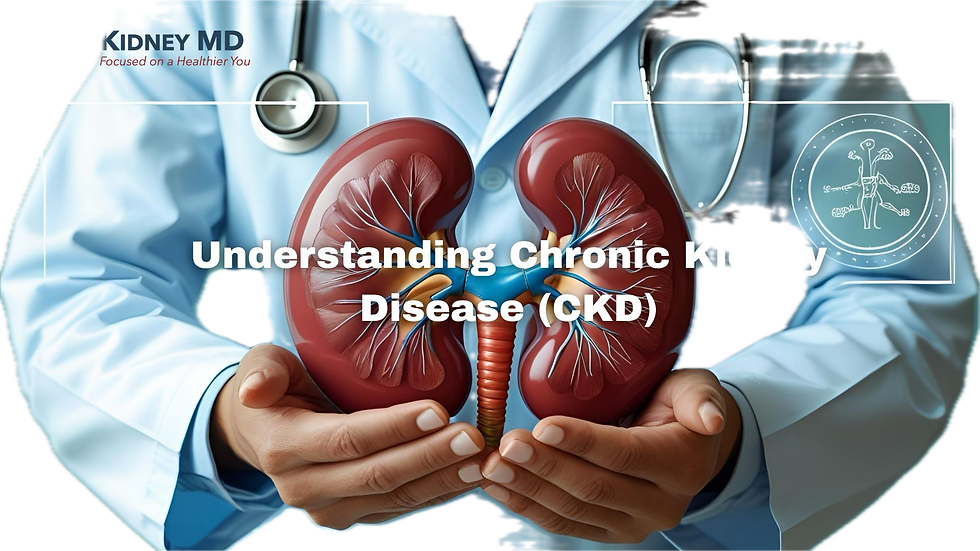What Is a Kidney Diet and Do I Really Need It?
- AdminKidneyMD
- Sep 16
- 3 min read
Updated: Sep 25

When you hear the phrase “kidney diet,” you may wonder—what does it mean, and who actually needs it? The answer isn’t the same for everyone. A kidney diet is not a “one-size-fits-all” plan, but for many people with chronic kidney disease (CKD), early nutrition changes can make a big difference in protecting kidney function and overall health.
What Is a Kidney Diet?

A kidney diet focuses on reducing the workload on your kidneys while lowering your risk of heart disease and other complications. Common features include:
Limiting sodium: Aim for less than 2,300 mg/day (about one teaspoon of salt). Too much sodium raises blood pressure and causes fluid buildup.
Moderating protein: About 0.8 g per kilogram of body weight per day is usually recommended for adults with CKD. Moderation is key—too much protein can overwork the kidneys, but too little can lead to muscle loss and malnutrition. To learn more, see our blog: The Protein Myth in Kidney Disease
Choosing more plant-based foods: Diets rich in fruits, vegetables, and whole grains—with fewer processed foods, red meat, and added sugars—are linked to slower CKD progression and better heart health.
Who Benefits Most From a Kidney Diet Early On?
Not everyone with CKD needs strict dietary changes immediately, but certain groups benefit most from early intervention:
Patients with diabetes or high blood pressure – These are the leading causes of CKD, and early dietary changes help control blood sugar, blood pressure, and kidney stress.
Patients with albuminuria or proteinuria – When protein leaks into the urine, it’s a sign the kidneys are under strain. Limiting dietary protein and sodium can slow damage.
Patients in CKD stages G3a–G4 (moderate to severe CKD, but not yet kidney failure) – At this stage, the kidneys still have reserve function, so nutrition changes can meaningfully delay progression.
Patients with early metabolic issues – Such as mild high potassium, high phosphorus, or metabolic acidosis. Adjusting the diet can help prevent complications.
Patients with cardiovascular risk factors – Obesity, high cholesterol, or inflammation increase risks of heart disease and CKD progression. A plant-dominant, low-sodium diet supports both kidney and heart health.
Why Early Intervention Matters
Studies show that people with significant protein in their urine (especially more than 3 g/day) slow their CKD progression and reduce their risk of dialysis when they moderate protein intake and restrict sodium.
Patients who start dietary adjustments before advanced kidney failure develops have better outcomes—slower decline in kidney function, less swelling, improved blood pressure, and fewer heart complications.
The Role of a Kidney Dietitian
Working with a registered dietitian is one of the best steps you can take. Dietitians personalize recommendations based on your labs, stage of CKD, and other health conditions. This may include adjusting:
Protein (too much strains kidneys, too little risks malnutrition)
Sodium (to control blood pressure and swelling)
Potassium and phosphorus (to prevent dangerous buildups as kidney function declines)
Acid-base balance (through more fruits, vegetables, and plant proteins)
A dietitian can also help you find foods you enjoy so changes feel realistic and sustainable.
The Bottom Line
A kidney diet is not about deprivation—it’s about protection. The patients who benefit most are those with diabetes, hypertension, albuminuria, or early-stage CKD with other risk factors. Starting nutrition changes early is powerful: it helps your kidneys last longer, lowers your risk of dialysis, and protects your heart.
If you have CKD, ask your healthcare team whether a referral to a kidney dietitian is right for you. Small changes in your plate today can add years of healthier living tomorrow.




Comments